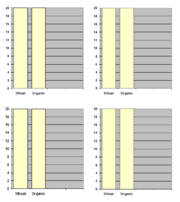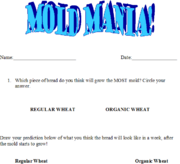Mold Mania
| Instant wiki maker | Making handouts | Editing tips |
Contents
Biology In Elementary Schools is a Saint Michael's College student project from a course that ran between 2007 and 2010 and fully described in this book chapter. The student-created resources have been preserved here for posterity. Link under 'toolbox' for printer-friendly versions of the exercises. Click on handouts to print full resolution versions. Please see Wikieducator's disclaimer, our safety statement, and the Creative Commons licensing in English and in legalese.
Student Worthiness
Tried and trusted
Safety
Mold can cause health problems such as allergic reactions, mycotoxin poisoning, and fungal infection. Because of these risks it is important that the plastic bags remain sealed once mold growth has occurred.
Also, do not allow students to play with toothpicks. Teachers should handle all sharp objects.
Primary Biological Content Area Covered
Fungus; scientific method; mold spores; observation skills; graphing; data collection; data analysis; toxicity of mold; organic products.
This activity will expose students to the scientific method and allow them to make predictions about mold growth. Mold, a type of fungus, grows from spores that can often be found in soil. Mold also frequently grows indoors and can be found on bread, the substance of choice for this experiment.
Materials
- Organic wheat bread (1 slice per pair of students)and regular wheat bread (1 slice per pair of students)
- Plastic bags (1 bag per piece of bread)
- Roll of Paper towels
- Soil/dirt
- Masking tape (for labeling bags)
- Magnifying glasses
- Marker
- Toothpicks
Handouts
Students will be given a worksheet guiding them through the scientific method and allowing them to form and test a hypothesis. Students will also have worksheets to illustrate predictions and observations, as well as a graphing worksheet to compare mold growth from white bread to wheat bread.
Figure 1 is a graphing tool that can be used to track the changes of the amount of mold growth on their bread. There are two bars that represent wheat bread and organic wheat bread. The mulitple graphs can be used to mark the days that the kids graph on. The students should mark the number of clusters of mold to correspond with the number on the Left side of the bar graph.
Description of Activity
Students will first hypothesize whether wheat bread or white bread will grow more mold. They will test the hypothesis using a simple and inexpensive set up. Bread will be placed in a plastic bag to be observed and never opened. Students will measure mold on a daily basis and record the data to graph later. Students will analyze the results when the experiment is complete.
Lesson Plan
- Introduction: Instructors introduce the idea of growing mold in a fun way. First, Show pictures of mold that are detailed and/or colorful. Ask students if they recognize what they see. Talk about how mold can be found in many households growing on food. Discuss how mold is a fungus, just like mushrooms, which are edible, unlike mold. It may be helpful to talk about the growing conditions for mold, the toxicity issues of mold and fungus, and the allegy issues associated with spores. Tell students they will get the opportunity to grow their own mold on bread. Students should be informed that they will be making observations, and recording data, as they would in any experiment. It will be helpful to talk about the scientific method in the introduction, but the depth of this discussion should be based on the grade level.
- As a group, students will discuss whether they think the organic bread or regular bread will grow more mold during the allotted time. The goal of this discussion is to form a hypothesis and record it as a group.
- Students will be given a worksheet that has two outlines of a piece of bread. Each outline represents either organic wheat bread or regular wheat bread. On these outlines students will draw their predictions of what each piece of bread will look like at the end of the experiment.
- Students will work in partners where each student is given a piece of bread (one organic wheat/ one regular wheat)
- Bread will be placed in plastic bag with dampened (not soaked) paper towel and a small amount of soil (a teaspoon should be fine).
- Students should leave some air in the bag, using the toothpicks to prop the inside of the bag so that some air remains inside the propped bag after the it is sealed. The bag must remained closed after the toothpick is placed inside. Care should be taken so that the toothpick does not puncture the bag. (Instructors should use their judgement about the competence of their students when handling sharp objects. All sharp objects should be handled carefully.)
- Students will use masking tape to label their bag organic wheat or regular wheat and put their name on the bag. (If you want to collect and graph class data, it may be helpful to number the bags.)
- Bags should be left in a warm location and observed each day under a magnifying glass.
- Students will count mold colonies on a daily basis and record their data to be graphed later.
- Graph recorded data (see worksheets).
- As a group, analyze results and say whether the hypothesis was supported.
- Conclusion: Discuss the role of preservatives in food. Ask students what they learned and see if they can come up with other experiments that can be done using the scientific method.
Potential Pitfalls
After we tried the experiment with 1 piece of white bread and 1 piece of wheat bread, we found that the mold growth was not evident after one week of observations. We decided to change the experiment to compare organic wheat bread versus regular wheat bread instead of comparing wheat bread and white bread.
Also, in order to complete this experiment the class will have to allow a lot of time for mold to grow. This experiment will not grow mold overnight! After two weeks, our first piece of bread has not grown mold. Changing the bread to wheat and organic we found that mold did actually grow, it just took longer than our targeted time, which was one week. Please allow at least three weeks for mold to grow. Be patient! Our bread did grow mold, slowly but surely!!!
Math Connections
Students will be able to record the number of mold circles or clusters that appear each day. Using these data, they can construct a graph to show this information. (Figure 1)
Literature Connections
Dowell, Frances O'Roark. Phineas L. MacGuire--gets Slimed! New York: Atheneum Books for Young Readers, 2007.
This book talks about mold growth where, when, and how it happens. This book could be used as an introduction to this experiment.
Connections to Educational Standards
The Vermont standard that this experiment covers is: Inquiry, Experimentation, and Theory Scientific Method 7.1 sections a-i
Next steps
After trying the first experiment, Students could try it again changing some variables. For instance, they could let all the air out of the bag and see if air affects the mold growth. Another variable students can change could be the amount of water or soil. Any changes to the original experiment may cause change and interest to the student. Changing one variable at a time is important so that you are able to see which variable makes a difference in the outcome of the experiment. Different experiments can bring up new questions of how and why the mold grows.
Citations and Links
http://www.billnye.com/ This website was used for the idea of how to contruct this experiment.
http://www.moldbacteria.com/myblog/2005_10_01_moldbacteria_archive.html Additional information can be found here.
Reflections
Overall this experiment worked well. One regret is not doing an experiment that allowed for instant gratification. Students would have been much more engaged and excited if they had been able to see some kind of change before their eyes. If students seem bored or anxious for results it is important to remind them that not all science is instant. However, the content goals were completed successfully and the lesson worked well. Students were especially engaged in the topics of mold, fungus, and organic foods.
One thing to be aware of when conducting this experiment is that there are safety issues involved in using mold, and students tended to be reckless and sometimes poke holes in their bags. Also, it is important to have a lot of time to work with this experiment. It takes several weeks for the bread to grow mold inside a sealed plastic bag. It is suggested for the class to set up this experiment a while before discussion about the topic.
Another thing that we found is that the students saw that chemicals did have something to do with how quickly the mold would grow. Unfortunately, many believed that the chemials used to preserve some of the ingredients in the non-organic bread helped to produce more mold.
Also, the concept of graphing is something that takes time to teach, and it might be helpful to do a whole seperate lesson based mainly on graphing, correlation, comparison, etc. It worked well to have students make predictions and talk about what they thought would happen. It was interesting to see when the children worked with their parents how they gave each other reasoning for why they picked the kind of bread to grow the most mold. It is important to keep this experiment paralleled with the scientific method because it allows for a richer learning experience and reasoning for students.



